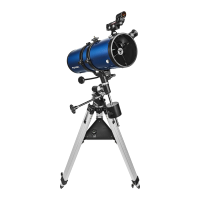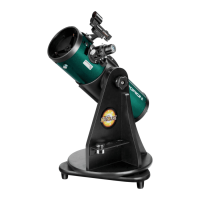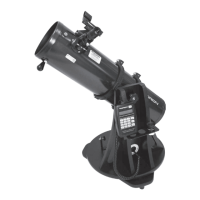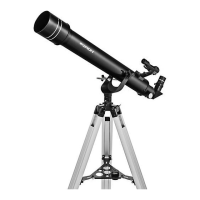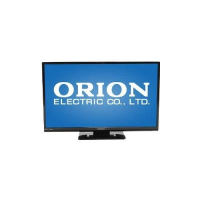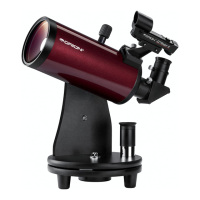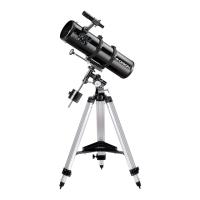9
One thing you DO NOT do is make any adjustment to the latitude
adjustment T-bolt. That will nullify the mount’s polar alignment.
Remember, once the mount is polar aligned, the telescope should
be moved only on the R.A. and Dec. axes. To point the scope
overhead, rst loosen the R.A. lock knob and rotate the telescope
on the R.A. axis until the counterweight shaft is horizontal (paral-
lel to the ground). Then loosen the Dec. lock knob and rotate the
telescope until it is pointing straight overhead. The counterweight
shaft is still horizontal. Then retighten both lock knobs.
Similarly, to point the telescope directly south, the counterweight
shaft should again be horizontal. Then you simply rotate the
scope on the Dec. axis until it points in the south direction.
What if you need to aim the telescope directly north, but at an
object that is nearer to the horizon than Polaris? You can’t do it
with the counterweight down as pictured in Figure 1a. Again,
you have to rotate the scope in R.A. so the counterweight shaft is
positioned horizontally. Then rotate the scope in Dec. so it points
to where you want it near the horizon.
Figure 10. This illustration show the telescope pointed in the four cardinal directions (a) north (b) south (c) east (d) west. Note that the
tripod and mount have not been moved; only the telescope tube has been moved in the R.A. and Dec. axes.
a b c d
Figure 11. Collimating the optics. (a) When the mirrors are properly aligned, the view down the focuser drawtube should
look like this.
(b) With the collimation cap in place, if the optics are out of alignment, the view might look something like this.
(c) Here, the secondary mirror is centered under the focuser, but it needs to be adjusted (tilted) so that the entire primary
mirror is visible.
(d) The secondary mirror is correctly aligned, but the primary mirror still needs adjustment. When the primary
mirror is correctly aligned, the “dot” will be centered, as in
(e).
a.
Primary mirror
center mark
Reflective surface
of collimation
cap
b.
c.
d.
e.
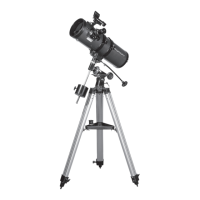
